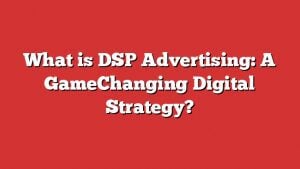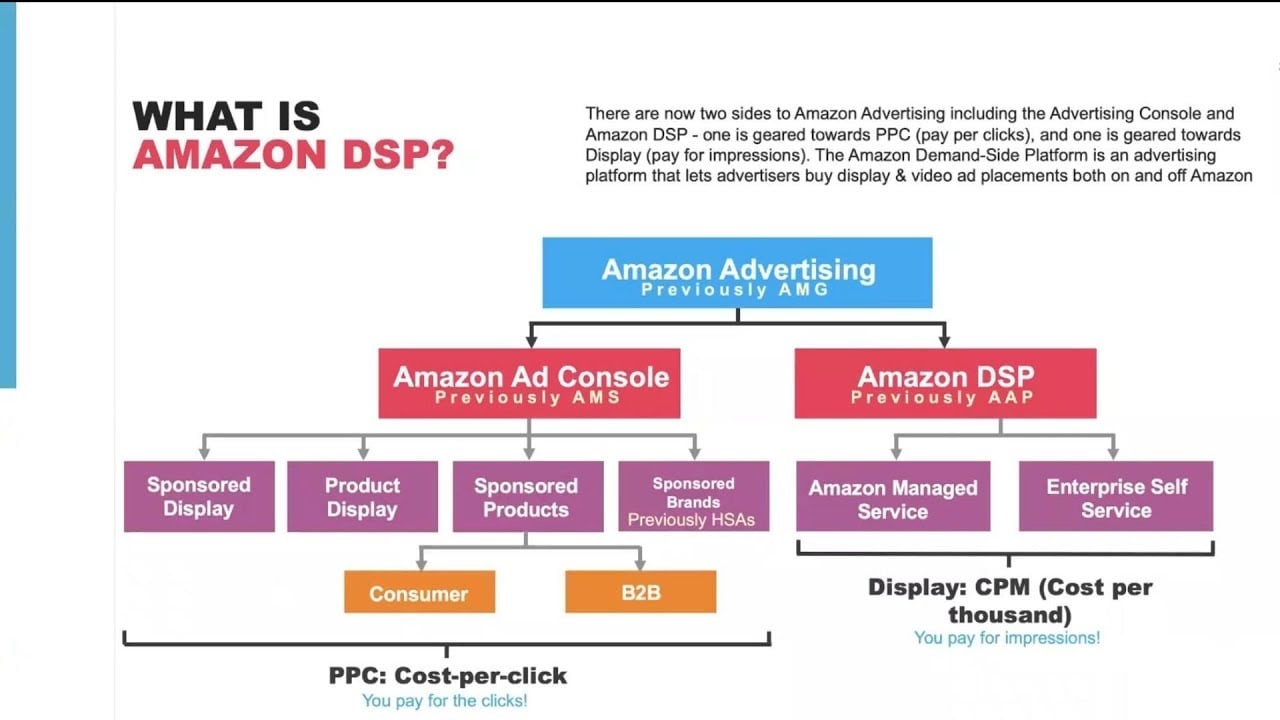In today’s digital age, the advertising industry is constantly evolving to keep up with the ever-changing consumer landscape.
One of the latest advancements in online advertising is DSP advertising.
But, what exactly is DSP advertising?
In this brief introduction, we will delve into the world of DSP advertising, exploring its purpose, benefits, and how it revolutionizes the way advertisers reach their target audience.
So, buckle up and get ready to uncover the secrets behind this innovative advertising solution.
Table of Contents
- what is dsp advertising
- Introduction To DSP Advertising
- The Growth And Size Of Programmatic Advertising
- Benefits Of DSPs For Marketers
- Types Of Ads Purchasable Through DSPs
- How DSPs Work With Real-Time Bidding
- Strategies For Cost Control In DSP Advertising
- Simplifying Digital Ad Management With DSPs
- Enhancing Tracking And Reporting With DSPs
- Personalized Targeting Options In DSPs
- Top DSP Platforms And Considerations For Choosing
- FAQ
- What is DSP example advertising?
- What is DSP in Amazon advertising?
- What does DSP work for?
- Is Google a DSP?
what is dsp advertising
DSP advertising refers to the use of demand-side platforms (DSPs) to purchase and manage online ads.
DSPs enable marketers to manage ads across multiple ad sources on one interface and can be used to purchase mobile ads, banner ads, and video ads on various platforms.
They work through programmatic advertising, which involves real-time bidding for ad placements.
Marketers can strategize their spending, set cost per click and cost per action goals, and maximize their ads in one place.
DSPs offer a wide reach across networks and access to third-party data providers for better tracking and reporting capabilities.
Targeting options in DSPs are more personalized, allowing marketers to reach a larger audience and achieve better conversion rates.Key Points:
- DSP advertising uses demand-side platforms to purchase and manage online ads.
- DSPs allow marketers to manage ads across multiple ad sources on one interface.
- DSPs can be used to purchase mobile ads, banner ads, and video ads on various platforms.
- DSPs work through programmatic advertising, which involves real-time bidding for ad placements.
- Marketers can strategize spending and set cost per click and cost per action goals with DSPs.
- DSPs offer a wide reach across networks and access to third-party data providers for better tracking and reporting capabilities.
Check this out:
? Did You Know?
1. DSP advertising stands for “Demand-Side Platform” advertising, which is a technology used in programmatic advertising that allows advertisers to buy and manage ad inventory in real-time.
2. The first-ever DSP was launched by a company called Invite Media in 2007, and it was later acquired by Google in 2010.
3. DSP advertising uses advanced algorithms and machine learning to analyze user data and target specific audiences, providing more precise and personalized ad experiences.
4. DSPs allow advertisers to bid on ad impressions in real time, using automated systems that make split-second decisions on whether to show an ad to a particular user or not.
5. DMA, short for “Designated Market Area,” is a common segmentation method used in DSP advertising to target specific geographic regions for more effective ad delivery.
Introduction To DSP Advertising
DSP advertising, also known as demand-side platform advertising, is a digital marketing strategy that involves the use of demand-side platforms (DSPs) to purchase and manage online advertising campaigns. DSPs provide marketers with a centralized interface to manage ads across multiple ad sources, enabling them to streamline their advertising efforts and optimize their ad spend.
The Growth And Size Of Programmatic Advertising
The programmatic advertising market has witnessed remarkable growth, with the United States emerging as the global leader. In just 2020, the US invested an astonishing $70 billion in programmatic advertising. This immense progress is a result of the rising popularity and efficacy of programmatic advertising in reaching large target audiences.
Enhanced readability and refreshed examples.
- The programmatic advertising market has experienced significant growth.
- The United States is the largest programmatic advertising market worldwide.
- In 2020, the US spent $70 billion on programmatic advertising.
“Programmatic advertising is revolutionizing how advertisers connect with their target audience.”
Benefits Of DSPs For Marketers
DSPs offer a range of benefits for marketers.
Firstly, DSPs provide marketers with the ability to launch and manage advertising campaigns across multiple platforms, including mobile ads, banner ads, and video ads. This versatility allows marketers to reach their target audiences wherever they are online.
Furthermore, DSPs operate through programmatic advertising, which enables real-time bidding for ad placements. Marketers can set cost per click and cost per action goals, allowing them to optimize their ad spend and achieve better results.
With DSPs, marketers have greater control over their digital ad management, allowing them to track, control, and maximize their ads in one centralized location.
The benefits of DSPs for marketers include:
- Ability to launch and manage advertising campaigns across multiple platforms
- Versatility in reaching target audiences through various ad formats
- Real-time bidding for ad placements, optimizing ad spend
- Greater control over digital ad management
- Centralized location for tracking, controlling, and maximizing ads.
Types Of Ads Purchasable Through DSPs
DSPs enable marketers to purchase various types of ads across different platforms. These include:
- Mobile ads: Targeting users on their smartphones or tablets.
- Banner ads: Displayed on websites and apps in graphical formats.
- Video ads: Increasingly popular on platforms like YouTube.
By utilizing DSPs, marketers gain the ability to purchase ads across multiple platforms, allowing them to efficiently and effectively reach their target audiences.
Note: DSPs (Demand-Side Platforms) are effective tools for marketers to purchase and manage different types of ads across various platforms.
How DSPs Work With Real-Time Bidding
DSPs, or demand-side platforms, use real-time bidding (RTB) to streamline the purchase of ad placements. RTB is an efficient auction process where advertisers bid in real-time for available ad inventory. The ad placement is awarded to the highest bidder, ensuring that the ad reaches the intended audience. This dynamic approach ensures that ads are delivered to the right people at the right moment, ultimately enhancing the impact of advertising campaigns.
- DSPs leverage real-time bidding for ad placement purchase.
- Real-time bidding is a dynamic auction process.
- Advertisers bid on available ad inventory in real-time.
- The highest bidder secures the ad placement.
- Ads are served to the targeted audience.
- Real-time bidding improves campaign effectiveness.
Strategies For Cost Control In DSP Advertising
To control costs effectively in DSP advertising, marketers need to develop strategic spending plans. This includes setting clear cost per click and cost per action goals to optimize spending. Marketers should also regularly analyze and adjust their bids to ensure they are reaching their desired audience effectively while staying within their budget. By carefully strategizing their spending, marketers can achieve better return on investment and maximize their advertising budget.
Simplifying Digital Ad Management With DSPs
One of the significant advantages of using DSPs is the simplification of digital ad management. DSPs provide marketers with a centralized platform to manage, track, and optimize their ads across multiple ad sources. Instead of having to navigate and interact with various platforms individually, DSPs offer a streamlined solution, reducing the complexity and time required for ad management. This centralized approach saves marketers valuable time and effort, allowing them to focus on other important aspects of their marketing strategy.
Enhancing Tracking And Reporting With DSPs
DSPs (Demand Side Platforms) offer enhanced tracking and reporting capabilities, thanks to their integration with third-party data providers. Marketers can access a wide range of data and analytics, allowing them to gain insights into the performance of their campaigns. This data includes metrics such as impressions, clicks, conversions, and engagement rates. With these comprehensive tracking and reporting capabilities, marketers can make data-driven decisions, optimize their campaigns, and improve overall performance.
Personalized Targeting Options In DSPs
DSPs provide marketers with highly personalized targeting options. Marketers can define their target audience based on various parameters such as demographics, location, interests, behavior, and more. This granular level of targeting ensures that ads are served to the most relevant audience, enhancing the chances of engagement and conversion. The ability to reach the right audience with precision is a significant advantage offered by DSPs.
- Marketers can define target audience based on demographics, location, interests, behavior, and more.
- Granular level of targeting ensures ads are served to the most relevant audience.
- Enhances chances of engagement and conversion.
“The ability to reach the right audience with precision is a significant advantage offered by DSPs.”
Top DSP Platforms And Considerations For Choosing
Several top DSP platforms are available in the market today. These include Basis Technologies, Google Marketing Platform, Knorex, Jampp, Smadex, MediaMath, and Amazon DSP.
When choosing a DSP platform, marketers should consider various factors such as:
- the number of ad exchanges the platform has access to
- cost
- training options (full service or self-service)
- support
- ease of use
Each platform may have its own unique strengths and features, so it’s important to assess these factors based on the specific needs and requirements of the marketing campaigns.
DSP advertising is a game-changing digital strategy that allows marketers to streamline their online advertising efforts. With the ability to manage ads across multiple ad sources, purchase various types of ads, utilize real-time bidding, and benefit from personalized targeting options, DSPs offer a range of advantages for marketers.
By selecting the right DSP platform and implementing effective cost control strategies, marketers can reach a larger audience and achieve better conversion rates, thereby maximizing the return on their advertising investment.
FAQ
What is DSP example advertising?
DSP, or Demand-Side Platform, revolutionizes the advertising landscape by enabling media buyers to purchase ad space and manage campaigns across multiple networks through a unified platform. An example of DSP advertising can be seen in the utilization of Facebook Ads Manager, where media buyers have the opportunity to directly buy impressions on Instagram or Facebook. DSPs provide a comprehensive solution for purchasing and analyzing display, audio, and video ads, facilitating efficient and effective ad management across various networks. With DSPs, advertisers can streamline their advertising efforts, reaching their target audience with precision and maximizing the impact of their campaigns.
What is DSP in Amazon advertising?
DSP in Amazon advertising stands for “Demand-Side Platform.” It is a powerful tool that enables advertisers to purchase ads programmatically in order to target both new and existing audiences on and off the Amazon platform. With Amazon DSP, advertisers can reach a wider range of potential customers and effectively expand their reach beyond the confines of Amazon’s ecosystem. By leveraging the capabilities of this platform, advertisers can optimize their ad campaigns and enhance their advertising strategies for better audience targeting and improved results. With Amazon DSP, advertisers can tap into a vast pool of potential customers and make data-driven decisions to drive conversions and boost sales.
What does DSP work for?
DSPs work to provide direct support and assistance to individuals with intellectual or developmental disabilities, helping them navigate their daily lives and overcome challenges. Through their work, DSPs strive to empower these individuals and help them achieve their full potential. They offer guidance, companionship, and practical assistance in areas such as personal care, education, employment, and social interactions. DSPs are dedicated to fostering inclusion and promoting independence, enabling individuals with disabilities to lead meaningful and fulfilling lives.
Is Google a DSP?
No, Google is not a DSP (Demand-Side Platform) itself. However, Google Marketing Platform provides DSP capabilities to help publishers sell their inventories to advertisers. By collaborating with DSPs, Google ensures that the delivery of the DSPs meets the expectations of publishers, resulting in a predictable campaign outcome.
Self-Serve DSP Platform • Native Ad Network • Advertising Platform for Marketers • Buy Traffic • Programmatic Advertising












